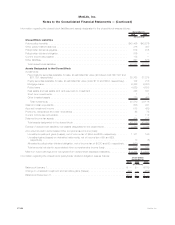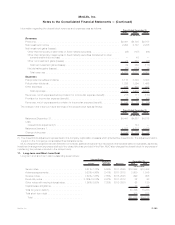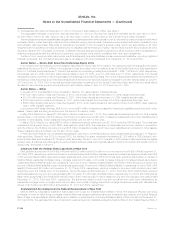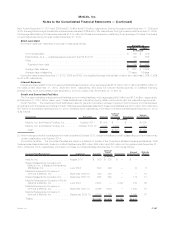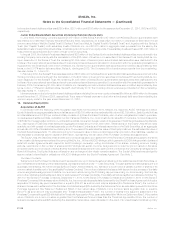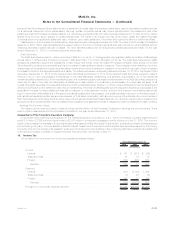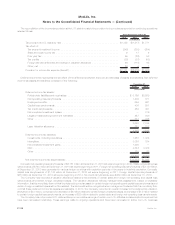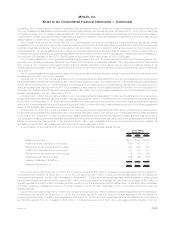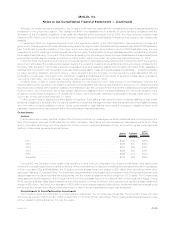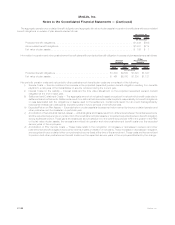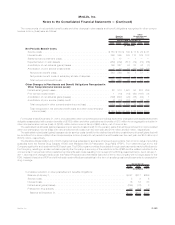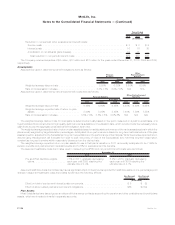MetLife 2010 Annual Report Download - page 203
Download and view the complete annual report
Please find page 203 of the 2010 MetLife annual report below. You can navigate through the pages in the report by either clicking on the pages listed below, or by using the keyword search tool below to find specific information within the annual report.aforementioned IRS settlements. Of the $22 million decrease, $20 million was reclassified to current income tax payable and was paid in
2009. The remaining $2 million reduced interest expense.
During the year ended December 31, 2008, the Company recognized $37 million in interest expense associated with the liability for
unrecognized tax benefits. At December 31, 2008, the Company had $176 million of accrued interest associated with the liability for
unrecognized tax benefits. The $42 million decrease from December 31, 2007 in accrued interest associated with the liability for
unrecognized tax benefits resulted from an increase of $37 million of interest expense and a $79 million decrease primarily resulting from
the aforementioned IRS settlements. Of the $79 million decrease, $78 million was reclassified to current income tax payable in 2008, with
$7 million and $71 million paid in 2008 and 2009, respectively. The remaining $1 million reduced interest expense.
The U.S. Treasury Department and the IRS have indicated that they intend to address through regulations the methodology to be followed
in determining the dividends received deduction (“DRD”), related to variable life insurance and annuity contracts. The DRD reduces the
amount of dividend income subject to tax and is a significant component of the difference between the actual tax expense and expected
amount determined using the federal statutory tax rate of 35%. Any regulations that the IRS ultimately proposes for issuance in this area will be
subject to public notice and comment, at which time insurance companies and other interested parties will have the opportunity to raise legal
and practical questions about the content, scope and application of such regulations. As a result, the ultimate timing and substance of any
such regulations are unknown at this time. For the years ended December 31, 2010 and 2009, the Company recognized an income tax
benefit of $87 million and $216 million, respectively, related to the separate account DRD. The 2010 benefit included an expense of
$57 million related to a true-up of the 2009 tax return. The 2009 benefit included a benefit of $33 million related to a true up of the 2008 tax
return.
16. Contingencies, Commitments and Guarantees
Contingencies
Litigation
The Company is a defendant in a large number of litigation matters. In some of the matters, very large and/or indeterminate amounts,
including punitive and treble damages, are sought. Modern pleading practice in the United States permits considerable variation in the
assertion of monetary damages or other relief. Jurisdictions may permit claimants not to specify the monetary damages sought or may permit
claimants to state only that the amount sought is sufficient to invoke the jurisdiction of the trial court. In addition, jurisdictions may permit
plaintiffs to allege monetary damages in amounts well exceeding reasonably possible verdicts in the jurisdiction for similar matters. This
variability in pleadings, together with the actual experience of the Company in litigating or resolving through settlement numerous claims over
an extended period of time, demonstrates to management that the monetary relief which may be specified in a lawsuit or claim bears little
relevance to its merits or disposition value.
Due to the vagaries of litigation, the outcome of a litigation matter and the amount or range of potential loss at particular points in time may
normally be difficult to ascertain. Uncertainties can include how fact finders will evaluate documentary evidence and the credibility and
effectiveness of witness testimony, and how trial and appellate courts will apply the law in the context of the pleadings or evidence presented,
whether by motion practice, or at trial or on appeal. Disposition valuations are also subject to the uncertainty of how opposing parties and their
counsel will themselves view the relevant evidence and applicable law.
On a quarterly and annual basis, the Company reviews relevant information with respect to litigation and contingencies to be reflected in
the Company’s consolidated financial statements. The review includes senior legal and financial personnel. Estimates of possible losses or
ranges of loss for particular matters cannot in the ordinary course be made with a reasonable degree of certainty. Liabilities are established
when it is probable that a loss has been incurred and the amount of the loss can be reasonably estimated. Liabilities have been established for
a number of the matters noted below. It is possible that some of the matters could require the Company to pay damages or make other
expenditures or establish accruals in amounts that could not be estimated at December 31, 2010.
Asbestos-Related Claims
MLIC is and has been a defendant in a large number of asbestos-related suits filed primarily in state courts. These suits principally allege
that the plaintiff or plaintiffs suffered personal injury resulting from exposure to asbestos and seek both actual and punitive damages. MLIC
has never engaged in the business of manufacturing, producing, distributing or selling asbestos or asbestos-containing products nor has
MLIC issued liability or workers’ compensation insurance to companies in the business of manufacturing, producing, distributing or selling
asbestos or asbestos-containing products. The lawsuits principally have focused on allegations with respect to certain research, publication
and other activities of one or more of MLIC’s employees during the period from the 1920’s through approximately the 1950’s and allege that
MLIC learned or should have learned of certain health risks posed by asbestos and, among other things, improperly publicized or failed to
disclose those health risks. MLIC believes that it should not have legal liability in these cases. The outcome of most asbestos litigation
matters, however, is uncertain and can be impacted by numerous variables, including differences in legal rulings in various jurisdictions, the
nature of the alleged injury and factors unrelated to the ultimate legal merit of the claims asserted against MLIC. MLIC employs a number of
resolution strategies to manage its asbestos loss exposure, including seeking resolution of pending litigation by judicial rulings and settling
individual or groups of claims or lawsuits under appropriate circumstances.
Claims asserted against MLIC have included negligence, intentional tort and conspiracy concerning the health risks associated with
asbestos. MLIC’s defenses (beyond denial of certain factual allegations) include that: (i) MLIC owed no duty to the plaintiffs— it had no special
relationship with the plaintiffs and did not manufacture, produce, distribute or sell the asbestos products that allegedly injured plaintiffs;
(ii) plaintiffs did not rely on any actions of MLIC; (iii) MLIC’s conduct was not the cause of the plaintiffs’ injuries; (iv) plaintiffs’ exposure occurred
after the dangers of asbestos were known; and (v) the applicable time with respect to filing suit has expired. During the course of the litigation,
certain trial courts have granted motions dismissing claims against MLIC, while other trial courts have denied MLIC’s motions to dismiss.
There can be no assurance that MLIC will receive favorable decisions on motions in the future. While most cases brought to date have settled,
MLIC intends to continue to defend aggressively against claims based on asbestos exposure, including defending claims at trials.
F-114 MetLife, Inc.
MetLife, Inc.
Notes to the Consolidated Financial Statements — (Continued)


